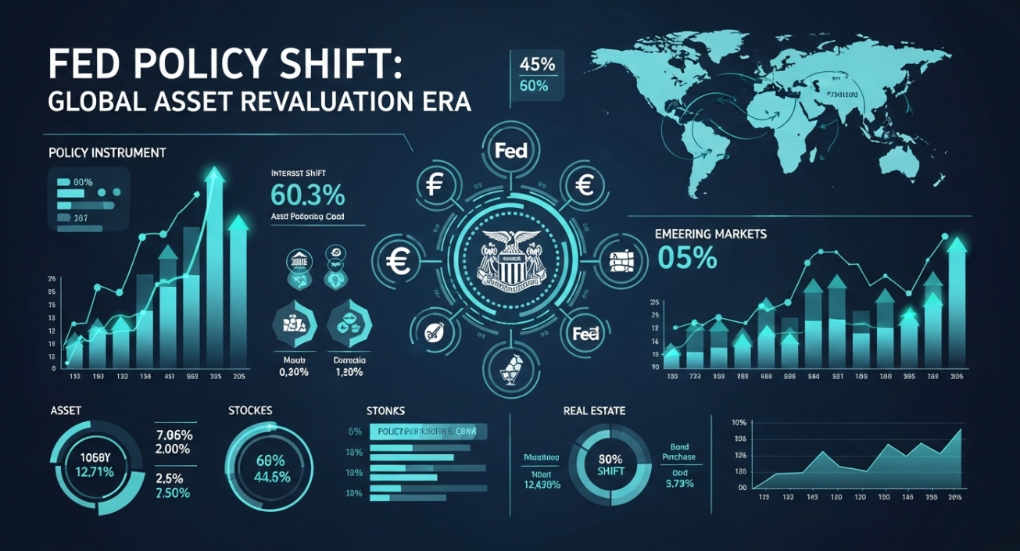The Federal Reserve's "double whammy" policy has detonated global markets, and the interconnected dynamics of the four major assets—USD, gold, cryptocurrencies, and US stocks—are undergoing profound changes.
The Federal Reserve's policy direction in October has become the focal point of global capital markets. On one hand, the Fed may pause its balance sheet reduction; on the other hand, market expectations for a rate cut in October are as high as 99%.
This policy shift is driven by multiple pressures, including a slowdown in the US economy, a weak labor market, and government shutdowns. This article will delve into the impacts of these two major policy shifts on the USD, gold, the crypto market, and US stocks, revealing the connections and opportunities for investors.

01 Policy Shift: The Fed's Dual Action
In the early hours of October 15, Beijing time, Fed Chairman Powell delivered a speech at the National Association for Business Economics event in Philadelphia, signaling a strong policy shift. This speech not only reinforced market expectations for a rate cut but also hinted that the quantitative tightening (QT) that has lasted for more than three years is about to come to an end.
Stopping Balance Sheet Reduction: A Cushion Against Tightening Liquidity
● Powell clearly stated, “We may be close to stopping balance sheet reduction in the coming months.” Since starting the balance sheet reduction in June 2022, the Fed's balance sheet has shrunk from a peak of nearly $9 trillion to about $6.6 trillion currently.
This action aims to address signs of tightening liquidity. Powell acknowledged that with rising repo rates, there have been some signs of tightening in the money market, and the Fed hopes to take a “very cautious” approach to avoid a repeat of the money market tensions seen in September 2019.
Rate Cut Expectations: Employment Market Sounds Alarm
● The strengthening of rate cut expectations directly stems from the deterioration of the employment market. Powell pointed out that “the downside risks to the labor market are increasing,” which has changed the Fed's assessment of risk balance.
According to the CME's "FedWatch" tool, after Powell's speech, the probability of a 25 basis point rate cut in October reached 97.3%, and the probability of a cumulative 50 basis point cut by December was 93.5%.
Regulatory Easing: Institutional Benefits for the Crypto Market
● 2025 is set to be a “watershed” year for US crypto regulation. In August, the Fed terminated the “Novel Activities Supervision Program,” incorporating bank crypto operations into its regular regulatory process.
At the same time, agencies like the FDIC and OCC have also abolished a series of restrictive rules, clearing the way for traditional financial institutions to enter the market. This series of policy adjustments marks a fundamental shift in regulatory thinking: from “first set defenses, then observe” to “incorporate into the framework, regulate development.”
02 Interconnected Assets: A Comprehensive Overview
The “double whammy” of the Fed pausing balance sheet reduction and rate cut expectations is reshaping the global asset landscape through three main channels: liquidity, risk aversion sentiment, and economic outlook.
The table below clearly illustrates the interconnected relationships among these assets:
Asset Class
Main Impact Logic
Expected Performance
Key Basis
US Dollar Index
Rate cuts weaken the dollar's interest rate advantage, leading to capital outflows
Expected to weaken
Dollar index below 100
Gold
Safe-haven demand + easing policies + central bank gold purchases
Significantly favorable
Gold hits a historical high, becoming the first asset with a total market value exceeding $30 trillion
Crypto Market
Regulatory easing vs. short-term risk aversion sentiment
Divergent fluctuations
Bitcoin rebounds after hitting a four-month low, ETF funds net outflow
US Stocks
Liquidity support vs. economic concerns suppressing
Structural divergence
Tech stocks lead declines, funds shift to defensive sectors
Source: Compiled by AiCoin
From the table, it can be seen that the Fed's policy shift impacts different assets in various ways—the dollar is directly hit, gold benefits from dual advantages, while risk assets (US stocks and the crypto market) are caught in a tug-of-war between economic concerns and liquidity improvements.
03 Transmission Mechanism Analysis: How Assets Are Revalued
Dollar Under Pressure: Downward Channel Under Rate Cut Pressure
● The Fed's easing monetary policy typically exerts downward pressure on the dollar. When the Fed cuts rates or pauses balance sheet reduction, the yield advantage of dollar assets is weakened, leading to capital outflows from dollar assets.
The dollar index is around 98.2, reflecting strong market expectations for the Fed's policy shift. Historically, the dollar's movement is highly correlated with the Fed's monetary policy. The weakening trend of the dollar index may be further reinforced with the implementation of the rate cut in October.
Gold Shines: Dual Benefits Propel Historical Highs
● Driven by the Fed's policy shift and geopolitical risks, gold has entered a strong upward trend. The Fed's pause in balance sheet reduction and rate cut expectations constitute a dual benefit for gold. On one hand, pausing balance sheet reduction alleviates concerns about tightening liquidity; on the other hand, rate cuts reduce the opportunity cost of holding gold.
● Spot gold prices once broke through $4,300 per ounce, reaching a historical high, becoming the first asset in human history with a total market value exceeding $30 trillion.
Gold's strength also stems from a structural change in global central bank purchases. Data from the World Gold Council shows that since 2022, global central bank gold purchases have surged, exceeding 1,000 tons for three consecutive years, double the average annual purchase of 473 tons from 2010 to 2021.
Crypto Market: Opportunities and Risks Coexist
The impact of the Fed's policy shift on the crypto market is complex, showing a clear duality.
● Policy easing brings benefits. The clarification of regulations has removed barriers for traditional financial institutions to enter the market. BlackRock's Bitcoin ETF has surpassed $40 billion in 200 days, indicating that institutional funds are accelerating their inflow.
● At the same time, the Fed's rate cuts may prompt some funds to flow out of money market funds and return to risk investments. Historical data shows that in the early stages of the Fed's policy shift, crypto assets often experience rebounds.
● Short-term adjustment pressure. Despite the favorable policy environment, the crypto market is currently facing adjustment pressure. Bitcoin once fell below $104,000, hitting a near four-month low.
Some analysts are cautious about Bitcoin's short-term trajectory. Ledn's Chief Investment Officer Jon Glover predicts that Bitcoin's bull market has ended, and the upcoming bear market will last at least until the end of 2026.
US Stock Market Dynamics: The Tug-of-War Between Liquidity and Earnings Concerns
The impact of the Fed's policy shift on US stocks is similarly complex.
● Liquidity support. Rate cuts and pausing balance sheet reduction mean improved liquidity in the financial system, which is favorable for US stocks, especially for interest-sensitive growth stocks.
Historical data shows that in the early stages of the Fed's policy shift, US stocks typically rise; the Nasdaq's decline was narrowed from 2.12% to 0.76% following Powell's speech.
● Economic concerns create suppression. However, this round of policy adjustment is also interpreted by the market as a confirmation of economic downturn, which may suppress corporate earnings expectations.
The Fed's Beige Book noted that economic activity growth has slowed in most regions, with core sectors like retail and real estate showing weak performance, and consumer spending willingness continuing to decline.
04 Historical Comparison: The Uniqueness of This Cycle
To better understand the current market environment, it is very meaningful to compare this round of policy shifts with historical periods:
Cycle Characteristics
2008 Crisis-style Rate Cuts
2019 Insurance-style Rate Cuts
2025 Risk Management-style Rate Cuts
Policy Background
Systemic financial crisis
Robust economy, risk prevention
Deteriorating labor market, sticky inflation
Rate Cut Magnitude
Aggressive rate cuts + QE
Slight adjustments, 3 rate cuts
Gradual steps, expected 2 cuts within the year
Market Response
Stock market plummets then rebounds
Moderate stock market rise
Structural divergence in the stock market, crypto market volatility
Crypto Market
Bitcoin was not yet mature
Bitcoin rose over 80% within the year
Institutions accelerate entry, regulatory easing
Main Risks
Financial system collapse
Trade war uncertainties
Sticky inflation, political interference in central bank independence
Source: Compiled by AiCoin
The rate cuts in 2025 resemble those in 2019: not an imminent crisis, but a combination of labor market downturn and sticky inflation uncertainties. It is neither as aggressive as in 2008 nor as passive as in 2001, but rather a “preventing recession, hedging risks” gradual easing.
05 Changing Asset Correlations: Reconstructing Investment Logic
From the analysis above, it can be seen that against the backdrop of the Fed's policy shift, the correlation of traditional assets is being reconstructed.
● Strengthening of the negative correlation between the dollar and gold: The weakening dollar contrasts sharply with the strengthening gold.
● Positive correlation between gold and risk assets: Gold and US stocks break the traditional safe-haven-risk pattern.
● Complexification of the crypto market's relationship with traditional assets: The crypto market no longer completely follows US stocks, showing independent volatility characteristics.
The core driving force behind this change in correlation is the shift in market logic—from “bad news is good news” (bad economy = policy easing = market rise) to “bad news is bad news” (bad economy = profit decline = market fall).
Research shows that the correlation between cryptocurrencies and traditional financial markets is deepening. The correlation coefficient between S&P 500 volatility and major crypto market prices has reached 0.7. This indicates that the crypto market is no longer isolated and is increasingly interconnected with the mainstream financial system.
The Fed's policy shift has become the core driving force behind the current asset revaluation. The weakening dollar, strengthening gold, short-term adjustments in the crypto market, and structural divergence in US stocks may continue for the next one to two quarters.
Investors should pay attention to the CPI data released on October 24 and the OPEC+ production meeting on November 2, as these factors will provide key clues for assessing the market's subsequent direction.
In a weak dollar cycle, asset rotation is accelerating, and seizing structural opportunities is more realistic than chasing a broad market rally.
Join our community to discuss and grow stronger together!
Official Telegram community: https://t.me/aicoincn
AiCoin Chinese Twitter: https://x.com/AiCoinzh
OKX benefits group: https://aicoin.com/link/chat?cid=l61eM4owQ
Binance benefits group: https://aicoin.com/link/chat?cid=ynr7d1P6Z
免责声明:本文章仅代表作者个人观点,不代表本平台的立场和观点。本文章仅供信息分享,不构成对任何人的任何投资建议。用户与作者之间的任何争议,与本平台无关。如网页中刊载的文章或图片涉及侵权,请提供相关的权利证明和身份证明发送邮件到support@aicoin.com,本平台相关工作人员将会进行核查。



